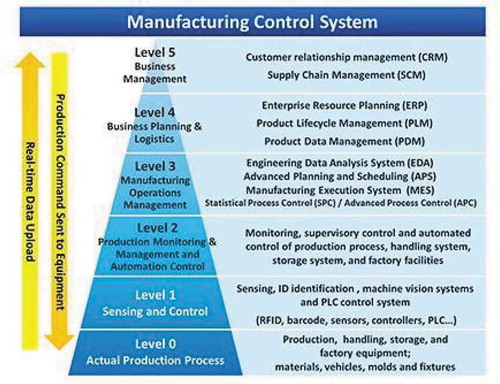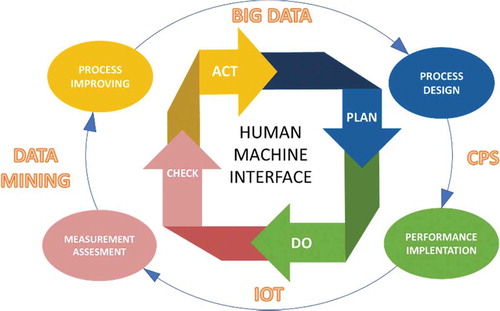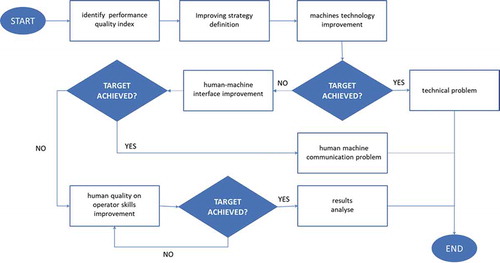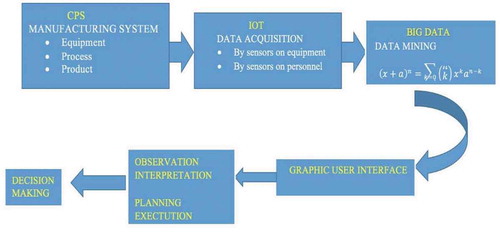ABSTRACT
Industry 4.0 is a new paradigm in the manufacturing world and it has deeply changed the Human–machine interaction. This paper focus is on the nature of this interaction, which is made possible thanks to the Internet of Things (IoT), and Cyber-Physical System (CPS). These Industry 4.0 key technologies are studied related to the standard Deming cycle, in order to underline the importance of Human–machine interaction. The Fourth Industrial Revolution involves several changes in the workforce’s key features. In this paper, a new perspective based on the centrality of humans is given in the new Industry era. The importance of the human factor will be deeply studied through the implementation of the ‘Sand Cone Model’. A new framework is proposed in order to explain the quality measures addiction on the workforce quality skills, and how it engraves on improving efficiency and effectiveness of an industrial process.
1. Introduction
The definition of ‘Industry 4.0’ spread in 2011 when an association made of business, politics and academia, named ‘Industrie 4.0’ supported the idea of a new kind of manufacturing industry (Drath & Horch, Citation2014).
The term ‘Industry 4.0’ describes the Fourth Industrial Revolution which is taking place in these years. This Revolution was preceded by three other Industrial Revolutions as it can be seen in : the first one took place in the second half of the eighteenth century and it sprang with new mechanical production facilities using water or steam power. The Second Industrial Revolution began in the 1870s because of the electrification system and Taylor’s work division with the mass production and the use of band conveyors. Finally, the Third Industrial Revolution can be associated with the introduction of the digital work and it took place in the 1970s. (Wittenberg, Citation2016).
Figure 1. Industry 4.0 evolution (Drath & Horch, Citation2014)
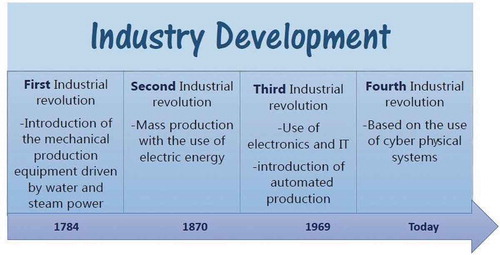
Industry 4.0 is a new concept of manufacturing, involving the industrial automation and integrating new production technologies, in order to improve work conditions and to increase productivity and quality.
Industry 4.0 brought a great change also in the interaction between workers and machines. The term ‘machine’ indicates every kind of dynamic technical system including automation, decision support equipment and software. The automation components of the technical system are denoted as supervision and control system.
As shown in , in this new concept, machines, which used to be located at level one, now take some functionalities from the upper levels, especially from the Level 3 (Manufacturing level, System and Management level) and Level 4 (Enterprise Resource Planning). Then, in Industry 4.0 paradigm, the automation supports human work not only in the production phase, logistics and data collection but in Business Management and ERP too.
2. Industry 4.0. key elements
Industry 4.0 is a popular term to describe the now coming changes of the industry landscape, particularly in the production and manufacturing industry (Xu & Li, Citation2018). The Fourth Industrial Revolution is one of the most trending topics in both professional and academic fields. This concept has Smart Manufacturing as its central element. Smart manufacturing is an emerging form of production-integrating manufacturing assets with sensors, computing platforms, communication technology, control, simulation, data-intensive modelling and predictive engineering (Kusiak, Citation2018).
Industry 4.0 has been considered a new industrial stage in which several emerging technologies are converging to provide digital solutions (Frank et al., Citation2019). The new paradigm of Industry 4.0 is a revolution, which allows communication between humans and machines throughout a highly networked environment (Gu & Liu, Citation2013), using automation technologies like Cyber-Physical Systems (CPS), Internet of Things (IoT) and cloud computing (Sony, Citation2018). CPS are integrations of computation and physical processes. Embedded computers and networks monitor to control the physical processes, usually with feedback loops (E. A. Lee, Citation2008). The proliferation of these devices, in a communicating–actuating network, creates the Internet of Things (IoT), wherein sensors and actuators blend seamlessly with the environment around us, and the information is shared across platforms (Gubbi et al., Citation2013). This revolution prompted industry to distribute its production processes on multiple sites, or better to decentralize them. This organizational structure generated a strong reality virtualization: its instrumental performance monitoring and remote management. So, decentralization and virtualization are paradigms moving to the Fourth Industrial Revolution (Hermann et al.,Citation2015).
Industry 4.0 arises and develops thanks to a new market where competition requires new concepts of manufacturing based on continuous flexibility and reconfigurability (Koren, Citation2006). Simulation tools, already used in different contexts (Di Nardo & Gallo et al., Citation2015), help this new paradigm of Industry. In fact, for the new manufacturing context, Wörn et al. (Citation2000) identify the processes of new approaches where simulation takes an important role (Di Nardo et al., Citation2016). As described by J Lee et al. (Citation2015) the CPS has a certain 5 c architecture, with 5 different levels: Connection, Conversion, Cyber, Cognition, and Configuration. The main characterization of this new kind of framework is a shift between centrally controlled processes to a decentralized one. Industry 4.0 is based on the concept of smart products, due to their smartness.
One of the principal pillar for the Fourth Industrial Revolution (Drath & Horch, Citation2014) is the concept of IoT. IoT is a world where sensors allow machines to talk to one another, producing a device-to-device (D2D) communication to facilitate peer-to-peer networks (Pawar & Privedi, Citation2018). Machines are connected as a collaborative community (J. Lee et al., Citation2014). In addition, the IoT is a game changing, hugely significant opportunity for the economy and business organizations. In Industry 4.0, IoT is expected to offer promising transformational solutions for the operation and role of many existing industrial systems within the digital enterprises of tomorrow’s complex industrial ecosystems (Brettel et al., Citation2014).
In addition to the IoT, the fusion of the physical and the virtual world is a further important component of Industry 4.0 (Drath & Horch, Citation2014). The development of CPS is characterized by three phases. Therefore, specifically, there are three enabling technologies implementing the 5 c architecture in all its phases: integrated sensors, actuators and decentralized intelligence.
The Fourth Industrial Revolution is based on the concept of ‘cognitive automation’ as a step between an industry model where robots replace people and another one where information runs fast and everything is perfectly synchronized.
Such a big innovation as Industry 4.0 needs also big changes in the workplace organization and in the workforce job satisfaction and organizational commitment. This is the reason why this paper will deal with HumanFactor and its robot interaction.
It is possible to talk about a new CHS (Cyber-human system) (), that updates the simple CPS, including some consideration on how the human element must be integrated, and how human factor is crucial in the higher levels. It is interesting to note that the activities deemed difficult to evolve in the cyber level are the very ones that humans perform naturally, and those, that are inherent in the cyber world, are the ones needing the most attention if we connect the human into the new ‘Internet-of-People-and-Things’ (Krugh & Mears, Citation2018). Unlike CPS, CHS has the ability to feedback information at each level, as human workers have an inherent intelligence that can be naturally leveraged for self-adaptive, corrective, and preventative actions. The configuration level of CHS acts as the supervisory control to ensure the decisions, made at the cognition level, are implemented and corrective or adaptive actions are followed through the human worker.
Figure 3. The CHS framework compared to the CPS (Krugh & Mears, Citation2018)

3. The evolution of man–machine interaction
Man–machine interaction (also known with the acronym of ‘MMI’ or with the name of Human–machine interaction (HMI)) is described as an interaction and communication between human users and machines in a dynamic environment through several interfaces. Ever since humans started to build tools, there was the interaction between the humans and the machines. This interaction has evolved over time. Initially, before the Second World War, people were adjusted to fit to machines. In other words, humans were trained to use the machines. However, in the Second World War, new equipment was developed so quickly that it was hard to sufficiently train humans. Therefore, the need for a systematic analysis and synthesis of the interaction between humans and machines arose. The history of Human–machine interaction can be split up into four time zones. First, in the years 1940 to 1955, developers tried to find the limits of human possibilities. New equipment was designed such that human controllers would just be able to deal with it. From 1955 to 1970, things advanced. In this time, researchers tried to model the humans like machines and design products accordingly. Around 1970, electronics were advancing. Then, from 1970 to 1985, this technology was used to automate many tasks, which normally required humans. The human ended being the controller and began becoming the supervisor. This advanced much more since 1985. Nowadays workload, cognitive process, emotional human–robot interaction models are taken into account.
Hence, human–machine interaction deeply changed through years and in Industry 4.0 reached a great innovation that can be explained thanks to some pillars of the Fourth Industrial Revolution:
Big data and analytics;
Robot-assisted production;
Self-driving logistics vehicles;
Augmented reality and additive manufacturing.
3.1. Big data and analytics
The introduction of Industry 4.0 in production involves a more specialized employee who is going to have several responsibilities working more with communication devices systematically.
Companies will use algorithms in order to analyze real-time data. While the use of big data will involve a reduction of number of workers, an industrial data scientist with skills to use statistical programming languages will be required (Kumar et al., Citation2015). The capability of managing big data develops competitive advantages to the firms.
The difference between the traditional worker and the worker of the Industry 4.0 is the competence and knowledge gap. The traditional worker was someone without experience and skills, the new worker is considered as someone who is going to deal with management not only with production.
3.2. Robot-assisted production
Robots will replace, in many cases humans. As a matter of fact, they are going to allow the decrease of manual labour in the production set (Ferdows & De Meyer, Citation1990).
The main consequence of the robot introduction will be the revolution of the workplace as robots will offer ergonomic improvements. There will be less physical effort for the worker because all routine jobs will be performed by machines. Every planning job will be left to the human who will monitor the production.
Robots will have a fundamental role in the dynamic environment of the production process because of their cognitive skill to re-adapt their status according to the flexible situation and the new inputs (Almada Lobo, Citation2015).
The role of robot coordinator will be created in order to supervise robots on the shop floor and in order to respond to malfunctions or error signals.
The robot coordinator will carry out both routine and emergency maintenance tasks and he will involve also other experts when needed. In case of the need to replace a robot, the coordinator will have this responsibility. The use of automation to assist workers will be particularly valuable in many developed countries. For example, as shown in , some automotive assembly-line work now requires heavy lifting and not ergonomic positions. A robotic device allows the worker to do his job in an easier and more ergonomic way, preventing errors and accidents. The flexibility of the process in Industry 4.0 will increase. Robots, smart machines and smart products that communicate with one another and make autonomous decisions will provide this flexibility (Rüßmann et al., Citation2015).
Figure 4. Use of robots in the production as ergonomic help (Ferdows & De Meyer, Citation1990)
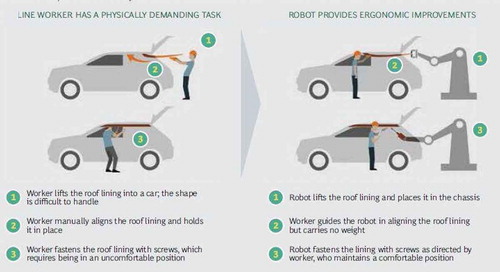
3.3. Self-driving logistics vehicles
In modern manufacturing environments, Automated Guided Vehicle Systems (AVGS) become an integral part of overall manufacturing systems. An AGVS (Automated Guided Vehicles System) contains one or more automated guided vehicles which are driverless vehicles used for horizontal movement of materials. AGVs are commonly used in facilities such as manufacturing plants, distribution centres, warehouses and transhipments.
The AVG is connected through wireless technologies and the communication between machine and workers is provided by easy interfaces. Information can circulate all over the system, in this way, every vehicle knows its status and others' status, so that the order is assigned to the vehicle that can carry out it in a more efficient way. Smart automative guided Vehicle allows easy collaboration between typical workers and robots improving production efficiency.
3.4. Augmented reality and additive manufacturing
In Industry 4.0, worker will be helped in his work by augmented-reality glasses to see dispatch information and navigation instructions, including the exact location of an item on a shelf, and to automatically scan a barcode. The system is also designed to allow a remote assistance with a basic type of maintenance. It is important to understand how the augmented reality will change the job in the factory, workers will receive repair instructions on how to replace a particular part, this information will be displayed through a device such as augmented-reality glasses or tablets (Ferdows & De Meyer, Citation1990).
Additive manufacturing allows the development and creation of products highly customizable. One of these characteristics is the 3D-printer, already used, that will spread in all the companies. Furthermore, with the digital development, it will be possible to create complex products in small lots, also because being realized in decentralized plants, distance and transport will not be any more a problem. This new scenario is characterized by a fully integrated data and product flows allowing a highly customized production, because the great communication between machines and humans reduces work-in-progress inventory ().
Figure 5. The supply chain in industry 4.0 (Ferdows & De Meyer, Citation1990)
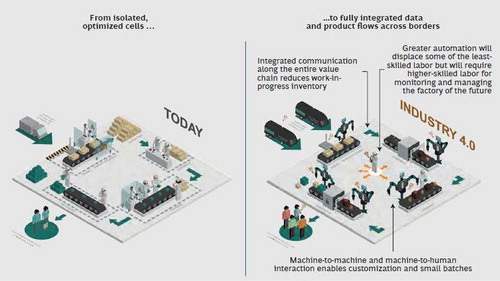
4. Man–machine collaboration in total quality environment
In order to achieve continuous improvement in the management aspects related to the new human–robot interaction, a framework is presented (), in which the potential of Industry Enabling Technologies 4.0 (Cyber-physical systems, Internet of Things, Data Mining and Big Data) are integrated with the standard Deming cycle (PLAN – DO – CHECK – ACT), that is a model designed for continuous quality improvement from a long-range perspective. It promotes a culture of quality in the workforce of a company and it focuses on the costumer relationship that becomes now an issue that employees can face with the help of machines. Quality is one of the various competitive strategic instruments in businesses. Thus, companies have noticed that quality is an important major factor for developing products and services. In addition, technologies enable companies for developing high-quality products and services. Nowadays, Total Quality Management (TQM) is a very important driver for the growth and success of companies in local and international markets. Implementing total quality management helps to increase the market share of companies and thus to improve their competitive capacity. Since customers demand better quality, lower prices, and quick response, improving the product and service quality of an organization is essential for business achievement. Total quality management is a management system and also an integrated philosophy, which improves the competitiveness of firms. In the global competitive markets, total quality management and technology have become two of the important factors for business achievement and organizational growth. All departments in a company are compelled to act together toward the same goals in order to be successful in the market. Also, they must recognize that all employees and activities influence others, and in turn, they are influenced by others. In order to improve competitiveness, companies search for a higher level of influence across all functions and processes. Companies implement total quality management and new technologies for staying in business (Bolatana et al., Citation2016). These new ‘smart’ factories are characterized by intelligent systems and machines (CPSs) which are interconnected and communicate through the network (Internet of Things, IoT) so that the planning phase (PLAN) is closely linked to their design. The data that comes from operating systems (DO) are collected and processed (Data Mining), allowing a real-time comparison between what is the real performance of the machines and standard operation that guarantees safety conditions for operators and the whole plant (CHECK). The availability of real-time monitoring of the ‘health state’ of machines and plants allows timely interventions (ACT) to restore ‘normal’ operation of those devices that send data that deviate from the standard operating parameters. ‘Intelligent’ sensors generate a large amount of data that could be important inputs for a re-design of machine and plant, as well as generating a history of interventions made on them that becomes valuable in building machine diary. This framework helps to understand how the methods and technologies typical of industry 4.0 are almost equal to a tool so well known and used for a long time as the Deming cycle to get quality.
5. The new sand cone: the proposed model
Once we analyzed the most important pillars in the interaction between man and machine, it is helpful to use the sand cone model in order to understand the role of the man in the Industry 4.0 concept. If automation is able to manage every aspect of production, now the role, that man assumes in this interaction, has to be studied and understood.
It is possible to get this aspect thanks to a proposed model that is an implementation of the Sand Cone Model, considered from a new perspective.
The Sand Cone model, as shown in , follows the road of the typical Trade-off models. It suggests that although in the short term it is possible to trade-off capabilities one against the other, there is actually a hierarchy amongst the four capabilities.
Figure 7. The sand cone model (Shroeder et al., Citation2010)
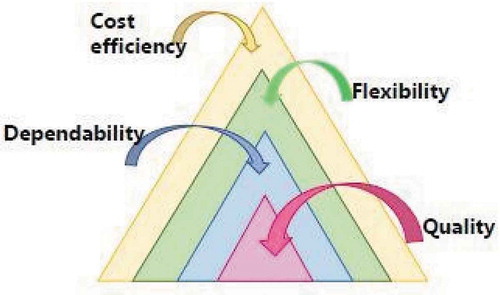
It is important to understand that the manufacturing process is based on the cumulation of four elements:
Quality
Dependability
Flexibility
Costs
In order to build cumulative and lasting manufacturing capability, the attention and resources should be stressed on the quality (Ferdows & De Meyer, Citation1990). Then, the Industry has to pay attention on improvement of the dependability of the production system, then the flexibility (or reaction speed). Finally, at the top of the sand cone, there is cost efficiency as the money saving (Shroeder et al., Citation2010).
This trade-off theory cannot be applied in all cases. Different approaches change the model vision by moving to a cumulative perspective – i.e. one capability is built upon another, not in its place.
When a manufacturer accumulates skills, he develops the first one and then moves to the next, in a sequence, starting from quality, passing through delivery and flexibility till the cost (Q–D–F–C). This sequence is supported by two main topics: quality (Q) and delivery (D) that improve the other two skills (F and C) (Boon-itt & Wong, Citation2016).
According to the original Sand Cone Model, previously presented in and all the studies shown as regard MMI, a new model of the sand cone can now be proposed. In this new framework, it is possible to see how much the human factor plays a fundamental role in the workplace and in the Industry more in general. In fact, in the new model on the bottom of the sand cone, as shown in , it is possible to see that the worker quality must be a milestone. It is very interesting to stress the concept that the quality in Industry 4.0 can be meant as the quality of the workers in the factory (Bolatana et al., Citation2016). In this new concept, it is possible to think about the reliability of the system as the human reliability. In this way, the efficiency and effectiveness of the whole system depend on the reliability of its each component individually and on the interaction between them designing man–machine collaboration in Total Quality Environment.
It is impossible to imagine the production-manufacturing plant quality without an excellent workforce quality. Therefore, the worker quality is the focus of the new Sand Cone. Unlike the other related papers mentioned above, this one proposes a new framework, in which human quality is crucial to face the complexity and the extremely flexible nature of the Industry 4.0. Without a focus on human skill, increasing the production manufacturing plant quality just from a technological point of view could be useless to a company. The process of digital transformation that companies are called to deal with, in order to be competitive and protagonists in the markets is not just a technological issue, but a skill one. In this new model, the reinforcing of the basis of workforce quality is crucial.
shows the new framework presented. It is a general framework of improvement focusing on human quality, which is the core of the new sand cone model.
Thanks to this new ‘best practice’ it is easy to understand how the main issue is the human quality on operator skill improvement, the only that generates a ‘loop’ in our flow chart. Without facing the ‘worker quality problem’, even thinking about a re-skilling where needed, there is no improvement and the main KPI identified cannot be achieved. This mind-set is the innovation and a revolution even in Industry 4.0 era, where all the focuses are around technology and machine automation.
The results of this framework can be validated considering and evaluating the KPIs before and after its application, getting the importance of having appropriate skills in the workforce.
Smart companies need to invest in training and updating of skills. It is possible to talk about an operation of ‘re-skilling’ or ‘skill revolution’.
Stewart and Hamlin (Stewart & Hamlin, Citation2011) highlight how working reality has become more and more a place for personal growth. For this one, a winning human resource management must necessarily get the following objectives:
Improvement of dynamics within individuals belonging to the same work team;
Continuous improvement of organization of work between different teams;
Development of a whole person;
Development by each operator of their increasingly qualifying skills and knowledge.
In order to achieve these aims, in a context of classification of operator’s aptitude profile, Leinweber (Hecklau et al., Citation2016) identified and grouped homogeneous groups in preparatory skills to work in a ‘smart company’:
Technical skills,
Methodological skills,
Attitude to teamwork,
Individual attitudes.
Collaborating with machines can be extremely useful but requires a preparation based on specific and unusual knowledge, which are not those used to date by typical employees.
6. Discussion
According to the mentioned 5 c architecture of CPS and CHS framework, human help is crucial not only to collect data and to turn them into added-value information but also and above all in the fourth phase of the framework: the cognition one, in which the devices can be just a support to the decision-making. Implementing CPS upon this level generates a thorough knowledge of the monitored system. Proper presentation of the acquired knowledge to expert users supports the correct decision to be taken. Since comparative information as well as individual machine status is available, decision on priority of tasks to optimize the production process can be made. For this level, proper info-graphics are necessary to completely transfer acquired knowledge to the users (J Lee et al., Citation2015).
So the goal of automation, in this case, will be to provide devices that will collect data and aggregate them and then provide them, in the most user-friendly way, to the person in charge of making appropriate decisions based on the data available (). This support is given by the HMI (Human–machine Interface). The graphic user interface must be well interpreted by operators in order to reach the Planning Execution phase. This aspect of interpretation is crucial, and it is with no doubt a human prerogative. The work of the machine, therefore, is submitted to human judgment: where this is positive, the approved action becomes a new stable operating model for the machine. The primary function of the worker will be to lead a production strategy and manage the implementation thereof the self-organizing production processes. In this way, the classic stationary workplace becomes less significant due to extensive networking and mobile real-time information availability. The worker will take on the role of the creative problem solver when compared with complex ones (Gorecky et al., Citation2014).
In fact, the framework of several companies is enriched by the figure of the Chief Information Officer (CIO) who will increasingly have a key role in defining the company strategy and in identifying key elements to increase profitability. The CIO is called to assume a key position, necessarily working closely with the CEO and CFO, to translate business data into business strategies and direct investments towards choices that lead to manage change, not to undergo it. As shown in organizations must have human resources with new skills to analyse and understand the growing demand for innovation. Multitasking people with skills that are not strictly related to their direct work environment and above all related to information technology will be increasingly requested.
By 2020, one-third of the skills required of employees will include skills that are not considered crucial for the role played today. In Industry 4.0-era, companies are no longer simply required to invest in technological infrastructures, but it becomes essential:
Driving and anticipating change: the ability to solve complex problems and critical thinking to help organizations adapt quickly to changes in perspective. Database analysis must involve data scientists to turn data into strategic business suggestions.
Valuing the human factor before technology: all companies need to reconsider their human resource models.
Managing all the new changes in digital technologies internally could be too expensive and time-consuming.
Therefore, the focus of this paper is on the worker quality. Knowledge, skills and experience of workers make the Human–machine Interface easier to understand so that the efficiency and effectiveness of the whole analysed system are increased. Human capital will remain the main resource for tackling the challenge of digitization at all levels.
7. Conclusions
The main aim of this paper is to study the development of Industry 4.0 and the nature of the interaction between man and machine. In order to do this, a brief Presentation of Industry 4.0 and historical notes are given.
In this work also the developments and changes of the workforce are discussed, especially the human factor has been analysed in the factory field. Consequently, the new industry concept has been discussed in order to move it on the interaction between these two factors: human one and machine one.
In the end, a new framework has been proposed, it well matches the sand cone model and the Deming cycle putting more emphasis on the human factor and the quality of the worker in the Industry. In this study, it is possible to understand why the Sand Cone has been modified. With the help of the CHS framework, the reader can understand how human skills are essential in the process leading to the decision-making phase and how human skills are an accelerator in the industry 4.0 universe.
A cue of improvement could be found in the dynamicity of the concept of Industry 4.0 itself, as a continuously improving world, the interaction will change in the next years. The model is under implementation in a Research Automotive Center and all the results will be published in future.
More studies are needed in order to follow closer to this innovation in the production world.
Disclosure statement
No potential conflict of interest was reported by the authors.
References
- Almada Lobo, F. (2015). The Industry 4.0 revolution and the future of manufacturing execution systems (MES). Journal of Innovation Management Almada-Lobo JIM, 3(4), 16–21. https://doi.org/10.24840/2183-0606_003.004_0003
- Bolatana, G. I. S., Gozlub, S., Alpkanb, L., & Zaim, S. (2016). The impact of technology transfer performance on total quality management and quality performance. Procedia: Social and Behavioural Science, 235, 746–755. https://doi.org/10.1016/j.sbspro.2016.11.076
- Boon-itt, S., & Wong, C. Y. (2016). Empirical investigation of alternate cumulative capability models: A multi-method approach. Production Planning & Control, 27(4), 299–311. https://doi.org/10.1080/09537287.2015.1124299
- Brettel, M., Friederichsen, N., Keller, M., & Rosenberg, M. (2014). How virtualization, decentralization and network building change the manufacturing landscape: An Industry 4.0 perspective, world academy of science, engineering and technology. International Journal of Information and Communication Engineering, 8(1).
- Di Nardo, M., Gallo, M., Madonna, M., & Santillo, L. C. (2015). A conceptual model of human behaviour in socio-technical systems. In H. Fujita & G. Guizzi (Eds.), Intelligent software methodologies, tools and techniques. SoMeT 2015, 598–609. Communications in computer and information science (Vol. 532). Springer.
- Di Nardo, M., Madonna, M., & Santillo, L. C. (2016). Safety management system: A system dynamics approach to manage risks in a process plant. International Review on Modeling and Simulations, 9(4), 256–264. 1974–9821. https://doi.org/10.15866/IREMOS.V9I4.9688
- Drath, R., & Horch, A. (2014). Industrie 4.0: Hit or hype? IEEE Industrial Electronics Magazine, 8(2), 56–58. https://doi.org/10.1109/MIE.2014.2312079
- Ferdows, K., & De Meyer, A. (1990). Lasting improvements in manufacturing performance: In search of a new theory. Journal of Operations Management, 9(2), 168–184. https://doi.org/10.1016/0272-6963(90)90094-T
- Frank, G., Santos Dalenogare, L., & Ayala, N. F. (2019, April). Industry 4.0 technologies: Implementation patterns in manufacturing companies. International Journal of Production Economics, 210(4), 15–26. https://doi.org/10.1016/j.ijpe.2019.01.004
- Gorecky, D., Schmitt, M., & Loskyll, M. (2014). Detlef Zühlke: Human-machine-interaction in the industry 4.0 era. 12th IEEE International Conference on Industrial Informatics (INDIN). https://doi.org./10.1109/INDIN.2014.6945523
- Gu, Y., & Liu, Q. (2013, April). Research on the application of the internet of things in reverse logistics information management. Journal of Industrial Engineering and Management, 6(4), 963–973. https://doi.org/10.3926/jiem.793
- Gubbi, J., Buyya, R., Marusic, S., & Palaniswami, M. (2013, September). Internet of things (IoT): A vision, architectural elements, and future directions. Future Generation Computer Systems, 29(7), 1645–1660. https://doi.org/10.1016/j.future.2013.01.010
- Hecklau, F., Galeitzke, M., Flachs, S., & Kohl, H. (2016). Holistic approach for human re source management in Industry 4.0. Procedia CIRP, 54, 1–6. https://doi.org/10.1016/j.procir.2016.05.102
- Hermann, M., Pentek, T., & Otto, B. (2015). Design Principles for Industrie 4.0 Scenarios: A Literature Review – Working Paper no.01/2015.
- Koren, Y. (2006). General RMS characteristics. comparison with dedicated and flexible. In Reconfigurable manufacturing systems and transformable factories (p. 27–45). Berlin: Springer.
- Krugh, M., & Mears, L. (2018). A complementary cyber-human systems framework for industry 4.0 cyber-physical systems. Manufacturing Letters, 15(partB), 89–92. https://doi.org/10.1016/j.mfglet.2018.01.003
- Kumar, R., Haleem, A., Garg, S. K., & Singh, R. K. (2015, January). Automated guided vehicle configurations in flexible manufacturing systems: A comparative study. International Journal of Industrial and Systems Engineering, 21(2), 207. https://doi.org/10.1504/IJISE.2015.071510
- Kusiak, A. (2018). Smart manufacturing. International Journal of Production Research, 56(1–2), 508–517, Leading scholars in Production Research for the 55th volume anniversary of IJPR. https://doi.org/10.1080/00207543.2017.1351644
- Lee, E. A. (2008). Cyber physical systems: Design challenges. 2008 11th IEEE International Symposium on Object and Component-Oriented Real-Time Distributed Computing (ISORC) (pp. 363–369). https://doi.org./10.1177/1753193408087104
- Lee, J., Bagheri, B., & Kao, H.-A. (2015). A cyber-physical systems architecture for Industry 4.0-based manufacturing systems. Manufacturing Letters, 3(1), 18–23. https://doi.org/10.1016/j.mfglet.2014.12.001
- Lee, J., Kao, H.-A., & Yang, S. (2014). Service innovation and smart analytics for Industry 4.0 and big data environment. Procedia CIRP,16, 3–8. https://doi.org/10.1016/j.procir.2014.02.001
- Pawar, P., & Privedi, A. (2018). Device-to-device communication based IoT system: Benefits and challenges. IETE Technical Review, 362–374. https://doi.org/10.1080/02564602.2018.1476191
- Rüßmann, M., (2015). Industry 4.0: The future of productivity and growth in manufacturing industries (p. 14). Boston Consulting Group.
- Shroeder, R. G., Shah, R., & Peng, D. X. (2010, November). The cumulative capability ‘sand cone’ model revisited: A new perspective for manufacturing strategy. International Journal of Production Research, 49(13), 4879–4901. https://doi.org/10.1080/00207543.2010.509116
- Sony, M. (2018). Industry 4.0 and lean management: A proposed integration model and research propositions. Production & Manufacturing Research, 6(1), 416–432. https://doi.org/10.1080/21693277.2018.1540949
- Stewart, J., & Hamlin, B. (2011). What is HRD? - A definitional review and synthesis of the HRD domain. Journal of European Industrial Training, 35(3), 199–222. https://doi.org/10.1108/03090591111120377
- Wittenberg, C. (2016). Human-CPS interaction- requirements and human-machine interaction methods for the industry 4.0. IFAC-PapersOnline, 49(19), 1–644. https://doi.org/10.1016/j.ifacol.2016.10.602
- Wörn, H., Frey, D., & Keitel, J. (2000). Digital factory – Planning and running enterprises of the future. 26th Annual Conference of the IEEE Industrial Electronics Society, 2, 1286–1291. doi:10.1109/IECON.2000.972307
- Xu, E. L., & Li, L. (2018). Industry 4.0: State of the art and future trends. International Journal of Production Research, 56(8), 2941–2962. https://doi.org/10.1080/00207543.2018.1444806

